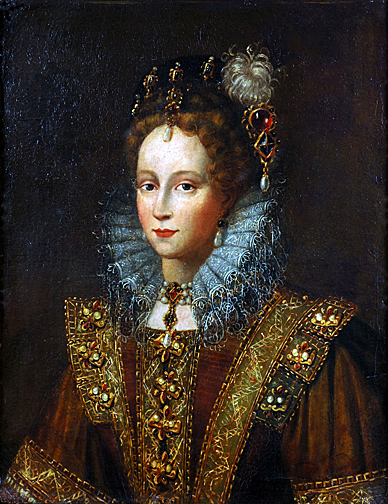
Portraiture of Elizabeth I of England
The portraits of Elizabeth I of England illustrate the evolution of English royal portraits in the Early Modern period from the representations of simple likenesses to the later complex imagery used to convey the power and aspirations of the state, as well as of the monarch at its head.
Even the earliest portraits of Elizabeth I of England (1533-1603) contain symbolic objects such as roses and prayer books that would have carried meaning to viewers of her day. Later portraits of Elizabeth layer the iconography of empire-globes, crowns, swords and columns-and representations of virginity and purity-such as moons and pearls-with classical allusions to present a complex "story" that conveyed to Elizabethan era viewers the majesty and significance of their Virgin Queen.

Portraits in Tudor England
Two portrait traditions had arisen in the Tudor court since the days of Elizabeth's father, Henry VIII. The portrait miniature developed from the illuminated manuscript tradition. These small personal images were almost invariably painted from life over the space of a few days in watercolors on vellum stiffened by being glued to a playing card. Panel paintings in oils on prepared wood surfaces were based on preparatory drawings and were usually executed at life size, as were oil paintings on canvas.
Unlike her contemporaries in France, Elizabeth never granted rights to produce her portrait to a single artist, although Nicholas Hilliard was appointed her official limner or miniaturist and goldsmith. George Gower, a fashionable court portraitist created Sergeant Painter in 1581, was responsible for approving all portraits of the queen created by other artists from that date until his death in 1596. Elizabeth sat to a number of artists over the years, including Hilliard, Cornelis Ketel, Federico Zuccaro or Zuccari, Isaac Oliver, and most likely to Gower and Marcus Gheeraerts the Younger.
Portraits were commissioned by the government as gifts to foreign monarchs and to show to prospective suitors. Courtiers commissioned heavily symbolic paintings to demonstrate their devotion to the queen. The fashionable long galleries of later Elizabethan country houses were filled with sets of portraits. The studios of Tudor artists produced images of Elizabeth working from approved "face patterns" or drawings of the queen to meet this growing demand for her image, an important symbol of loyalty and reverence for the crown in times of turbulence.
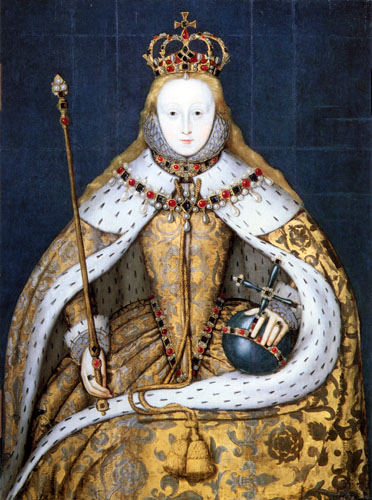
Elizabeth I in Coronation Robes: ca 1600-10
Portrait of Elizabeth I of England in her coronation robes. Copy ca 1600-1610 of a lost original of c. 1559. The pose echoes the famous portrait of Richard II in Westminster Abbey, the earliest known portrait of a British sovereign.

Elizabeth I of England: ca: 1585-90
One of many portraits of its type, with a reversed Darnley face pattern, ca 1585-90, artist unknown.
European Context
By far the most impressive models available to English portrait artists were the many portraits by Hans Holbein the Younger, the outstanding Northern portraitist of the first half of the century, who had made two lengthy visits to England and been Henry VIII's court artist. Holbein had accustomed the English court to the full-length life-size portrait, although none of his originals now survive. His great dynastic mural at Whitehall Palace, destroyed in 1698, and perhaps other original large portraits, would have been familiar to Elizabethan artists.
Both Holbein and his great Italian contemporary Titian had combined great psychological penetration with a sufficiently majestic impression to satisfy their royal patrons. By his second visit Holbein was already moving away from a strictly realist depiction; in his Jane Seymour "the figure is no longer seen as displacing with its bulk a recognizable section of space: it approaches rather to a flat pattern, made alive by a bounding and vital outline". This tendency was to be taken much further by the later portraits of Elizabeth, where "Likeness of feature and an interest in form and volume have gradually been abandoned in favor of an effect of splendid majesty obtained by decorative pattern, and the forms have been flattened accordingly".
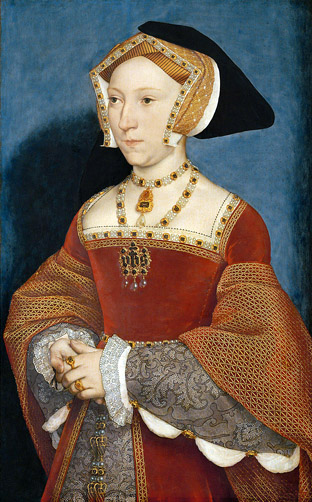
Hans Holbein's Portrait of Jane Seymour
Titian continued to paint royal portraits, especially of Philip II of Spain, until the 1570's, but in sharply reduced numbers after about 1555, and he refused to travel from Venice to do them. The full length portrait of Philip (1550-51) now in the Prado was sent to Elizabeth's elder sister and predecessor Queen Mary I of England in advance of their marriage.
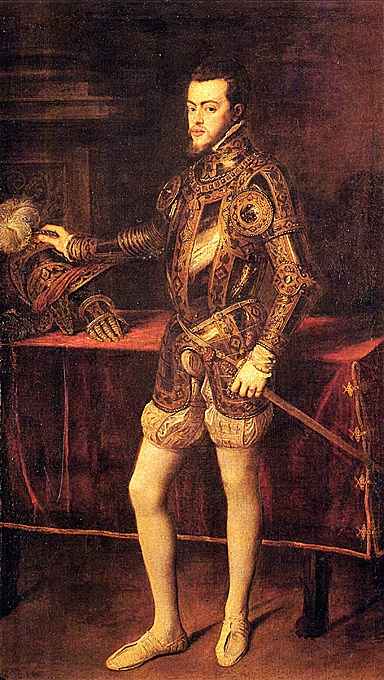
Philipp II as Prince: 1550-51
by Titian
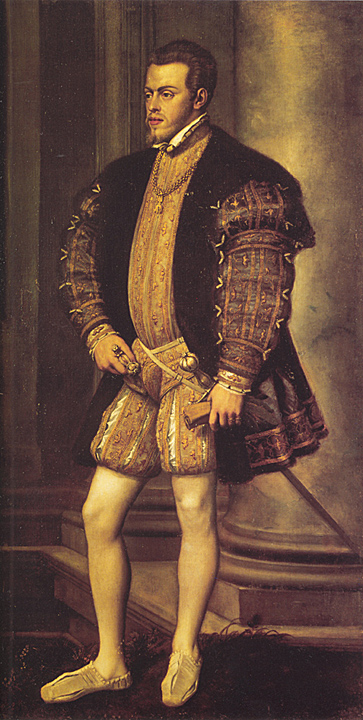
Portrait of Philip II
by Titian
Towards the mid-century the most influential Continental courts came to prefer less revealing and intimate works, and at the mid-century the two most prominent and influential royal portraitists in paint, other than Titian, were the Netherlands' Anthonis Mor and Agnolo Bronzino in Florence, besides whom the Habsburg court sculptor and medalist Leone Leoni should also be mentioned. Mor, who had risen rapidly to prominence in 1540's, worked across Europe for the Habsburgs in a tighter and more rigid version of Titian's compositional manner, drawing also on the North Italian style of Moretto. Mor had actually visited London in 1554, and painted three versions of his well-known portrait of Queen Mary; he also painted English courtiers who visited Antwerp.
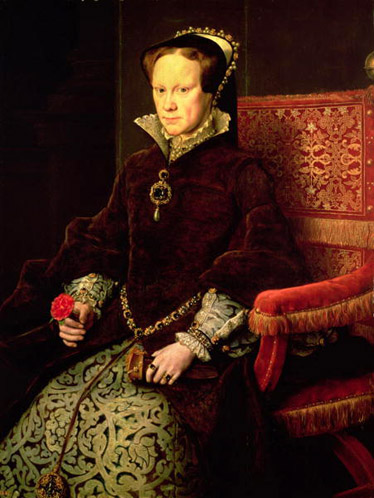
Mary I of England
by Anthonis Mor
The painting represents Mary Tudor, the bride of Philip II, King of Spain. This is the masterpiece of the artist, painted in England.
Philip II and Mor became acquainted during the prince's visit to the Netherlands in the early 1550's. In 1554, when Philip went to London for his marriage to Mary Tudor, he brought Mor to paint the queen's portrait, a representative work that reveals the essence of his style. In keeping with the prevailing manner of court portraiture, Mor is concerned with physiognomic accuracy but not with expression. This is a reticent image that emphasizes the social distinction of the sitter instead of her personality, although it is subtly encoded with a complex set of allusions. However, the austerity is somewhat relieved by the attention paid to the costume and jewelry, which are rendered with a technique of dazzling exactitude.
Quoted From: Web Gallery of Art - Mary Tudor
Mor's Spanish pupil Alonso Sánchez Coello continued in a stiffer version of his master's style, replacing him as Spanish court painter in 1561. Sofonisba Anguissola had painted in an intimately informal style, but after her recruitment to the Spanish court as the Queen's painter in 1560 was able to adapt her style to the much more formal demands of state portraiture. Moretto's pupil Giovanni Battista Moroni was Mor's contemporary and formed his mature style in the 1550's, but few of his spirited portraits were of royalty, or yet to be seen outside Italy.
Bronzino developed a style of coldly distant magnificence, based on the Mannerist portraits of Pontormo, working almost entirely for Cosimo I, the first Medici Grand-Duke. Bronzino's works, including his striking portraits of Cosimo's Duchess, Eleanor of Toledo were distributed in many versions across Europe, continuing to be made for two decades from the same studio pattern; a new portrait painted in her last years, about 1560, exists in only a few repetitions. At the least many of the foreign painters in London are likely to have seen versions of the earlier type, and there may well have been one in the Royal Collection.
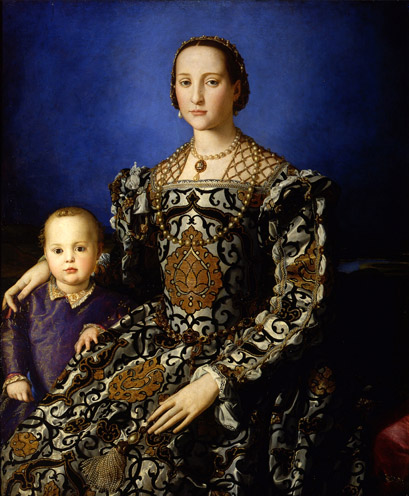
Portrait of Eleanor of Toledo and Her Son: 1545
French portraiture remained dominated by small but finely drawn bust-length or half-length works, including many drawings, often with colour, by François Clouet following, with a host of imitators, his father Jean, or even smaller oils by the Netherlands' Corneille de Lyon and his followers, typically no taller than a paperback book. A few full-length portraits of royalty were produced, dependent on German or Italian models.
Creating the Royal Image
William Gaunt contrasts the simplicity of the 1546 portrait of Elizabeth Tudor as a Princess with later images of her as queen. He wrote, "The painter...is unknown, but in a competently Flemish style he depicts the daughter of Anne Boleyn as quiet and studious-looking, ornament in her attire as secondary to the plainness of line that emphasizes her youth. Great is the contrast with the awesome fantasy of the later portraits: the pallid, mask-like features, the extravagance of headdress and ruff, the padded ornateness that seemed to exclude all humanity."

Elizabeth Tudor as a Princess: ca 1546
by an Unknown Artist
The lack of emphasis given to depicting depth and volume in her later portraits may have been influenced by the Queen's own views. In the Art of Limming Hilliard cautioned against all but the minimal use of chiaroscuro modeling that we see in his works, reflecting the views of his patron: "seeing that best to show oneself needeth no shadow of place but rather the open light...Her Majesty..chose her place to sit for that purpose in the open alley of a goodly garden, where no tree was near, nor any shadow at all..."
From the 1570's, the government sought to manipulate the image of the queen as a object of devotion and veneration. Sir Roy Strong writes: "The cult of Gloriana was skillfully created to buttress public order and, even more, deliberately to replace the pre-Reformation externals of religion, the cult of the Virgin and saints with their attendant images, processions, ceremonies and secular rejoicing." The pageantry of the Accession Day tilts,the poetry of the court, and the most iconic of Elizabeth's portraits all reflect this effort. The management of the queen's image reached its heights in the last decade of the reign, when realistic images of the aging queen were replaced with an eternally youthful vision defying the reality of the passage of time.
The Young Queen
Portraits of the young queen, many of them likely painted to be shown to prospective suitors and foreign heads of state, show a naturalness and restraint similar to those in the portrait of Elizabeth as a princess.

The Clopton Portrait: ca 1558–60
The full-length Hampden image of Elizabeth in a red satin gown by Steven Van Der Meulen has been identified by Sir Roy Strong as an important early portrait, "undertaken at a time when her image was being tightly controlled. 'This is a portrait dating from the mid to late 1560's, one of a group produced in response to a crisis over the production of the royal image, one which was reflected in the words of a draft proclamation dated 1563,' he said." The draft proclamation (never published) was a response to the circulation of poorly-made portraits in which Elizabeth is shown "in blacke with a hoode and cornet", a style she no longer wore. Symbolism in these pictures is in keeping with earlier Tudor portrait artists; in some Elizabeth holds a book (possibly a prayer book) suggesting studiousness or piety. In other paintings she holds or wears a red rose, symbol of the Tudor Dynasty's descent from the House of Lancaster, or white roses, symbols of the House of York and of maidenly chastity. In the Hampden portrait, Elizabeth wears a red rose on her shoulder and holds a gillyflower in her hand. Of this image, Strong says "'Here Elizabeth is caught in that short-lived period before what was a recognizable human became transmuted into a goddess'."
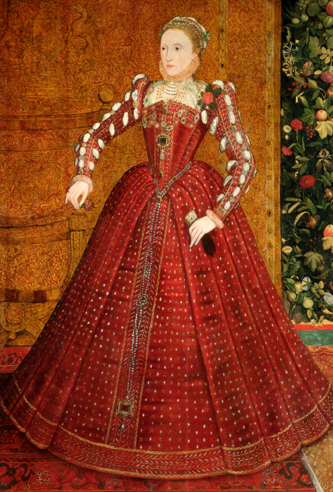
Elizabeth I by Steven Van Der Meulen
The Hampden Portrait
One artist active in Elizabeth's early court was the Flemish miniaturist Levina Teerlinc who had served as a painter and gentlewoman to Mary I and stayed on as a Gentlewoman of the Privy Chamber to Elizabeth. Teerlinc is best known for her pivotal position in the rise of the portrait miniature. There is documentation that she created numerous portraits of Elizabeth I, both individual portraits and portraits of the sovereign with important court figures, but only a few of these have survived and been identified.
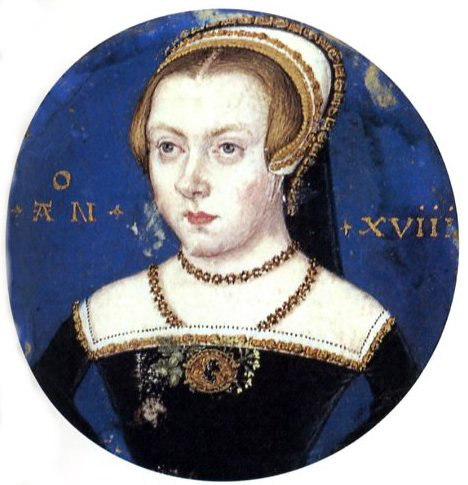
Elizabeth I as a Princess: ca 1550
by Levina Teerlinc
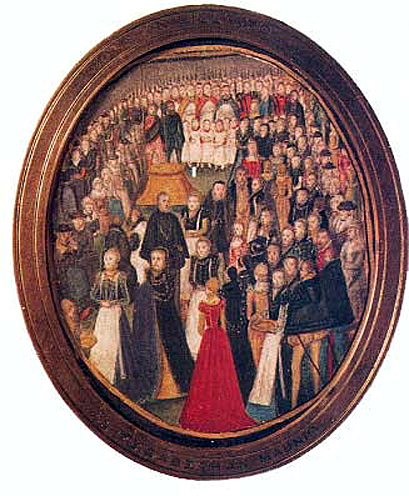
Elizabethan Maundy by Levina Teerlinc

Elizabeth I: ca 1565
by Levina Teerlinc
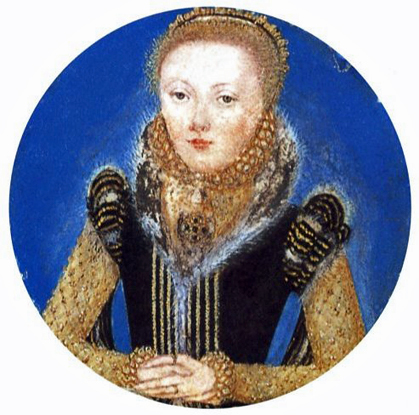
Another Variation by Levina Teerlinc
Elizabeth and the Goddesses
Two surviving allegorical paintings show the early use of classical mythology to illustrate the beauty and sovereignty of the young queen. In Elizabeth I and the Three Goddesses (1569), attributed to Hans Eworth, the story of the Judgment of Paris is turned on its head. Elizabeth, rather than Paris, is now sent to choose among Juno, Venus, and Pallas-Minerva, all of whom are outshone by the queen with her crown and royal orb. As Susan Doran writes, "Implicit to the theme of the painting ... is the idea that Elizabeth's retention of royal power benefits her realm. Whereas Paris's judgment in the original myth resulted in the long Trojan Wars 'to the utter ruin of the Trojans', hers will conversely bring peace and order to the state" after the turbulent reign of Elizabeth's sister Mary I.
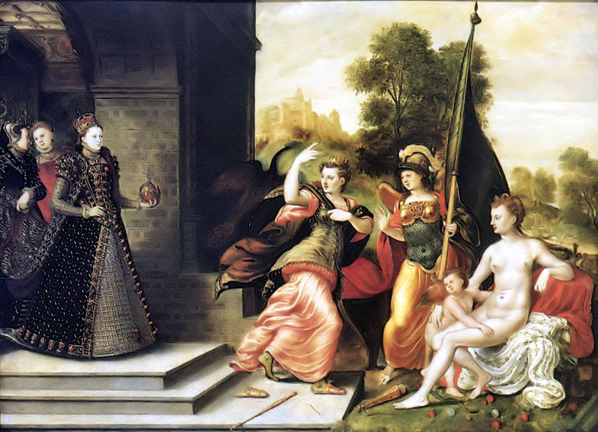
Elizabeth I and the Three Goddesses: 1569
The latter theme lies behind the 1572 The Family of Henry VIII: An Allegory of the Tudor Succession (attributed to Lucas de Heere). In this image, Catholic Mary and her husband Philip II of Spain are accompanied by Mars the god of War on the left, while Protestant Elizabeth on the right ushers in the goddesses Peace and Plenty. An inscription states that this painting was a gift from the queen to Francis Walsingham as a "Mark of her people's and her own content" and this may indicate that it commemorates the signing of the Treaty of Blois (1572) which established an alliance between England and France against Spanish aggression in the Netherlands during Walsingham's tour of duty as ambassador to the French court. Strong identifies both paintings as celebrations of Elizabeth's just rule by Flemish exiles to whom England was a refuge from the religious persecution of Protestants in the Spanish Netherlands.
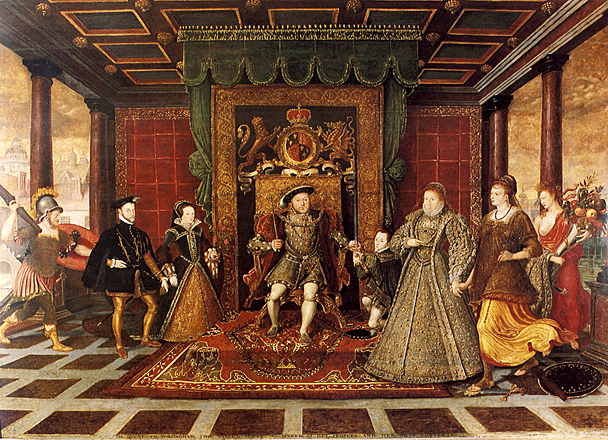
Family of Henry VIII, an Allegory of the Tudor Succession
The inscription shows that the work was a gift for Francis Walsingham, to whose family its provenance can be traced. Along the bottom, it reads: "THE QUENE. TO. WALSINGHAM. THIS. TABLET. SENTE. MARKE. OF. HER. PEOPLES. AND HER. OWNE. CONTENTE". Inscription around the frame: "A FACE OF MUCHE NOBILLITYE LOE IN A LITLE ROOME. FOWR STATES WITH THEYR CONDITIONS HEARE SHADOWED IN. A SHOWE A FATHER MORE THEN VALYANT. A RARE AND VERTUOUS SOON. A ZEALUS DAUGHTER IN HER KIND WHAT ELS THE WORLD DOTH KNOWE. AND LAST OF ALL A VYRGIN QUEEN TO ENGLANDS JOY WE SEE SUCCESSYVELY TO HOLD THE RIGHT, AND VERTUES OF THE THREE".
Mixing portraiture and allegory, the painting anachronistically shows Henry VIII, his three children, and Queen Mary's husband, Philip of Spain, alongside figures from mythology. Henry sits on his throne in the center, with his son Edward, the future Edward VI, kneeling beside him receiving the sword of justice. Henry died in 1547, but on the left of the picture his daughter Mary is shown next to Philip, whom she didn't marry until 1554 when she was queen, with Mars, god of war, behind them, symbolizing the wars they fought. Elizabeth, by contrast, stands on the right of the picture holding the hand of Peace, who treads the sword of discord underfoot, as Plenty attends with her cornucopia. Painted in Elizabeth's reign ca 1572, the picture stresses her legitimate descent from the Tudor dynasty and her role as a bringer of peace and prosperity to the realm.
Quoted From: Family of Henry VIII, an Allegory of the Tudor Succession
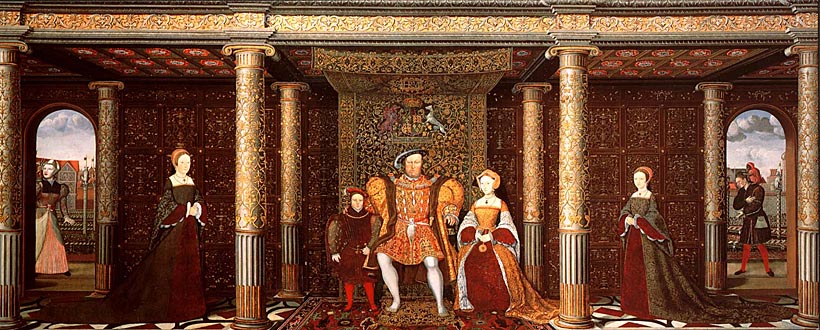
Family of Henry VIII: ca 1545
Hilliard and the Queen
Nicholas Hilliard was an apprentice to the Queen's jeweler Robert Brandon, a goldsmith and city chamberlain of London, and Sir Roy Strong suggests that Hilliard may also have been trained in the art of limning by Levina Teerlinc. Hilliard emerged from his apprenticeship at a time when a new royal portrait painter was "desperately needed."
Hilliard's first known miniature of the Queen is dated 1572. It is not known when he was formally appointed limner (miniaturist) and goldsmith to Elizabeth, though he was granted the reversion of a lease by the Queen in 1573 for his "good, true and loyal service." Two panel portraits long attributed to him, the Phoenix and Pelican Portraits, are dated ca 1572-76. These paintings are named after the jewels the queen wears, her personal badges of the pelican in her piety and the phoenix. National Portrait Gallery researchers announced in September 2010 that the two portraits were painted on wood from the same two trees. They also found that a tracing of the Phoenix portrait matches the Pelican portrait in reverse. They therefore deduce that both pictures of Elizabeth in her forties were painted around the same time.
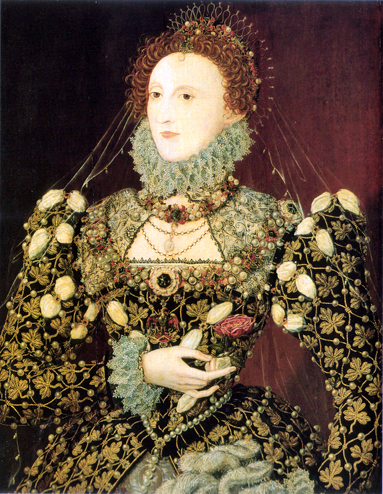
The Phoenix Portrait: ca 1575
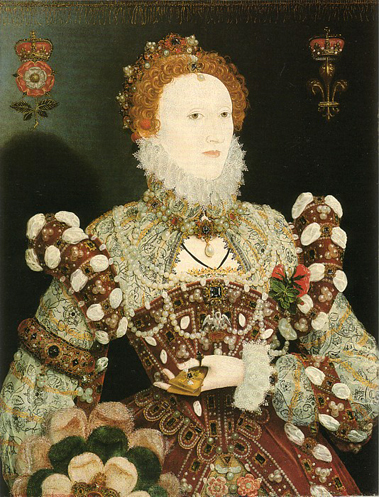
The Pellican Portrait Elizabeth I
But Hilliard's panel portraits seem to have been found wanting, and in 1576 the recently married Hilliard left for France to improve his skills. Returning to England, he continued to work as a goldsmith, and produced some spectacular "picture boxes" or jeweled lockets for miniatures: the Armada Jewel, given by Elizabeth to Sir Thomas Heneage and the Drake Pendant given to Sir Francis Drake are the best known examples. As part of the cult of the Virgin Queen, courtiers were rather expected to wear the Queen's likeness, at least at Court.

The Armada Jewel
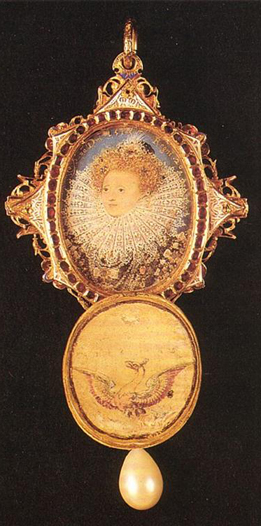
The Drake Pendant
His appointment as miniaturist to the Crown included the old sense of a painter of illuminated manuscripts and he was commissioned to decorate important documents, such as the founding charter of Emmanuel College, Cambridge (1584), which has an enthroned Elizabeth under a canopy of estate within an elaborate framework of Flemish-style Renaissance strap work and grotesque ornament. He also seems to have designed woodcut title-page frames and borders for books, some of which bear his initials.
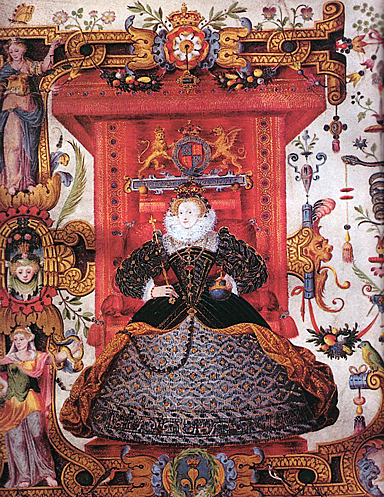
Emmanuel College Charter: 1584
Minatures by Nicholas Hilliard
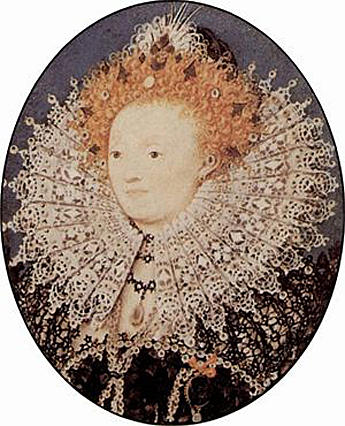
Hilliard Minature Elizabeth I: 1587

Hilliard Minature Elizabeth I: 1595-1600
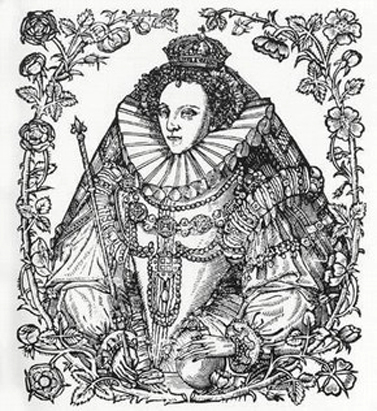
Elizabeth I flanked by Tudor Roses and Eglantine, 1588
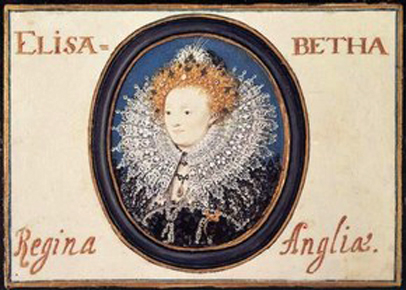
Nicholas Hilliard, portrait of Queen Elizabeth I, 1586-1587
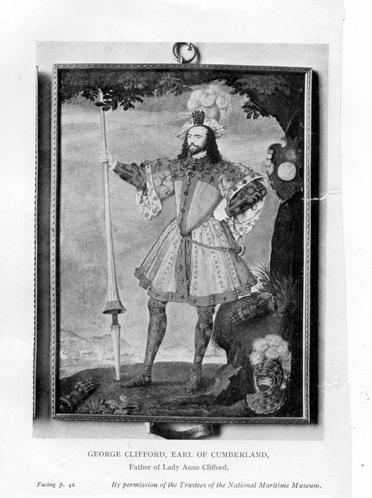
Hilliard Minature George Clifford
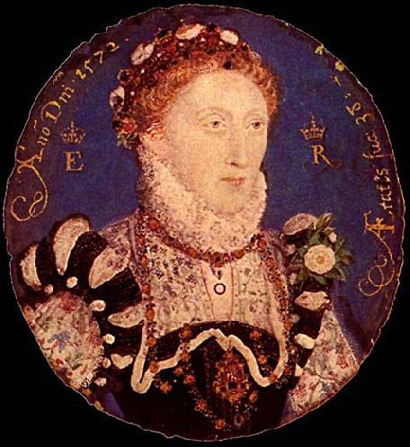
Miniature by Hilliard: 1572
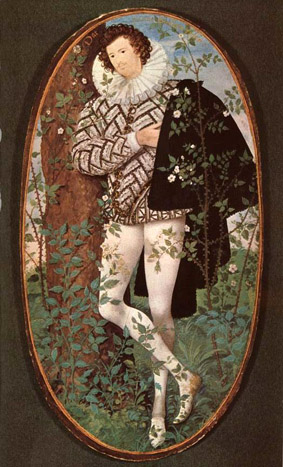
Nicholas Hilliard, Young Man Among the Roses, 1585-95
The Darnley Portrait
The problem of an official portrait of Elizabeth was solved with the Darnley Portrait. Likely painted from life around 1575-76, this portrait is the source of a face pattern which would be used and reused for authorized portraits of Elizabeth into the 1590's, preserving the impression of ageless beauty. Sir Roy Strong has suggested that the artist is Federico Zuccari or Zucaro, an "eminent" Italian artist, though not really a specialist portrait-painter, who is known to have visited the court briefly with a letter of introduction to Elizabeth's favorite Robert Dudley, 1st Earl of Leicester dated 5 March 1575. Zuccaro's preparatory drawings for full-length portraits of both Leicester and Elizabeth survive, although it is unlikely the full-length of Elizabeth was ever painted.
The Darnley Portrait features a crown and scepter on a table beside the queen, and was the first appearance of these symbols of sovereignty separately used as props (rather than worn and carried) in Tudor portraiture, a theme that would be expanded in later portraits.
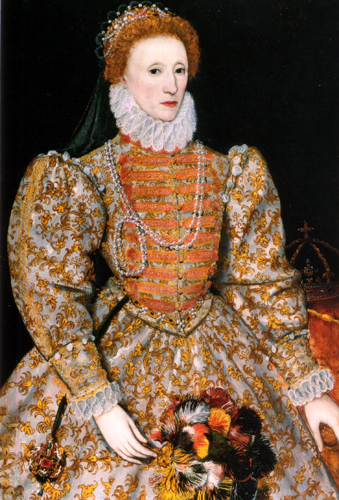
The Darnley Portrait: ca 1575
Return of the Golden Age
The excommunication of Elizabeth by Pope Pius V in 1570 led to increased tension with Philip II of Spain, who championed the Catholic Mary, Queen of Scots, as the legitimate heir of his late wife Mary I. This tension played out over the next decades in the seas of the New World as well as in Europe, and culminated in the invasion attempt of the Spanish Armada.
It is against this backdrop that the first of a long series of portraits appears depicting Elizabeth with heavy symbolic overlays of imperial dominion based on mastery of the seas. Combined with a second layer of symbolism representing Elizabeth as the Virgin Queen, these new paintings signify the manipulation of Elizabeth's image as the destined Protestant protector of her people.
Strong points out that there is no trace of this iconography in portraits of Elizabeth prior to 1579, and identifies its source as the conscious image-making of John Dee, whose 1577 General and Rare Memorials Pertaining to the Perfect Arte of Navigation encouraged the establishment of a British Empire supported by a strong navy, asserting Elizabeth's claims to imperial status via her supposed descent from Brutus of Troy and King Arthur.
Dee's inspiration lies in Geoffrey of Monmouth's History of the Kings of Britain, which was accepted as true history by Elizabethan poets and formed the basis of the symbolic history of England. In this twelfth century pseudo-history, Britain was founded by and named after Brutus, the descendent of Aeneas who founded Rome. The Tudors, of Welsh descent, are heirs of the most ancient Britons and thus of Aeneas and Brutus. By uniting the Houses of York and Lancaster following the strife of the Wars of the Roses, the Tudors ushered in a united realm where Pax reigned. The Spenserian scholar Edwin Greenlaw states "The descent of the Britons from the Trojans, the linking of Arthur, Henry VIII, and Elizabeth as Britain's greatest monarchs, and the return under Elizabeth of the Golden Age are all commonplaces of Elizabethan thought." This understanding of history and Elizabeth's place in it forms the background to the symbolic portraits of the latter half of her reign.
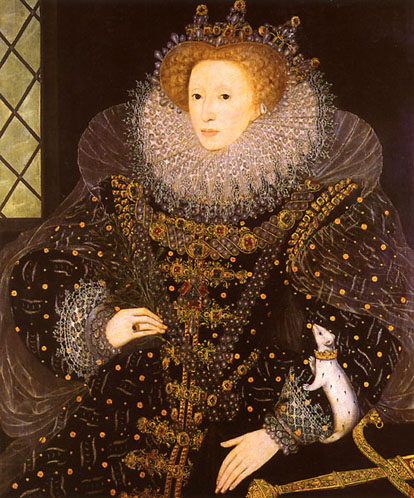
Elizabeth as Pax: 1585
(aka The Ermine Portrait)
The Ermine Portrait 1585, by Nicholas Hilliard. This portrait can be viewed at Hatfield House. Why is Elizabeth seated with an ermine? It was the symbol of royalty; and, if you look closely at the animal, you can see the gold crown it wears. The crown symbolizes majesty and purity. As for the bejeweled black gown and background - black and white were the queen's favorite colors. Also, the deep, dark color reinforces the symbolic gravity of the painting.
Quoted From: Portraits of Queen Elizabeth I
The Virgin Queen
A series of Sieve Portraits copy the Darnley face pattern and add an allegorical overlay that depicts Elizabeth as Tuccia, a Vestal Virgin who proved her chastity by carrying a sieve full of water from the Tiber River to the Temple of Vesta without spilling a drop. The first Sieve Portrait was painted by George Gower in 1579, but the most influential image is the 1583 version by Quentin Metsys (or Massys) the Younger.
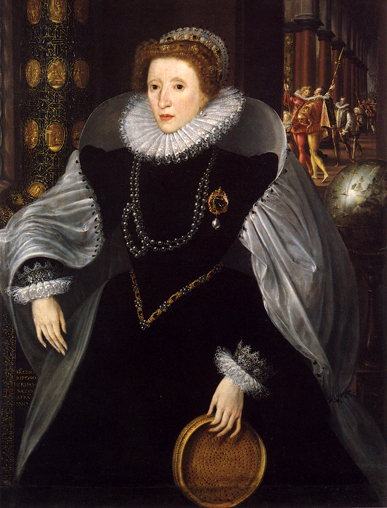
Elizabeth I, The Sieve Portrait: ca 1583
The sieve is a symbol of chastity and purity, originally taken from Petrarch's Triumph of Chastity. In the story, a Roman Vestal Virgin proves her purity by carrying water in a sieve and not spilling one drop. The sieve thus reinforces Elizabeth's image as 'the virgin queen'. The rim of the sieve is inscribed: A TERRA ILBEN / AL DIMORA IN SELLA' (The good falls to the ground while the bad remains in the saddle).
The figure to the right of Elizabeth is possibly her courtier Sir Christopher Hatton. His white hind badge is just barely visible on the figure's cloak. If so, then it is possible that Hatton commissioned this portrait; he may have met Metsys during a trip to Antwerp in 1573.
The roundels behind the queen depict the story of Aeneas and Dido, with the queen compared to Aeneas. Like the classical hero, she has faced temptation (marriage) and now leads a powerful nation. The globe behind the queen continues this theme. Ships are crossing west on the globe, possibly an allusion to England's conquest of the New World. TVTTO VEDO ET MOLTO MANCHA ('I see all and much is lacking') is inscribed on the globe. The portrait itself is inscribed: STANCHO RIPOSO & RIPO SATO AFFA NNO ('Weary I am and, having rested, still am weary.')
Quoted From: Portraits of Queen Elizabeth I
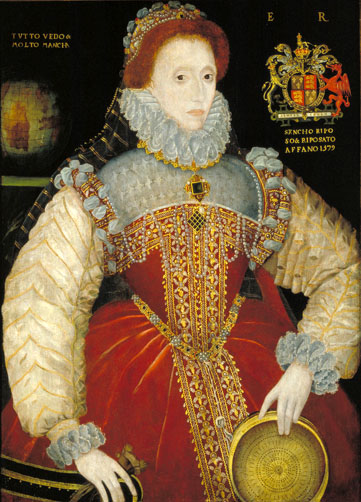
The Plimpton Sieve Portrait: 1579
by George Gover
In the Metsys version, Elizabeth is surrounded by symbols of empire, including a column and a globe, iconography that would appear again and again in her portraiture of the 1580's and 1590's, most notably in the Armada Portrait of ca 1588. The medallions on the pillar to the left of the queen illustrate the story of Dido and Aeneas, ancestor of Brutus, suggesting that like Aeneas, Elizabeth's destiny is to reject marriage and found an empire. This painting's patron was likely Sir Christopher Hatton (his heraldic badge of the white hind appears on the sleeve of one of the courtiers in the background), and the work may express opposition to the proposed marriage of Elizabeth to François, Duke of Anjou.
_1588.jpg)
Elizabeth I (Armada Portrait): 1588
The virgin Tuccia was familiar to Elizabethan readers from Petrarch's "The Triumph of Chastity". Another symbol from this work is the spotless ermine, wearing a collar of gold studded with topazes. This symbol of purity appears in the Ermine Portrait of 1585, attributed to the herald William Segar. The queen bears the olive branch of Pax (Peace), and the sword of justice rests on the table at her side. In combination, these symbols represent not only the personal purity of Elizabeth but the "righteousness and justice of her government."
Visions of Empire
The Armada Portrait is an allegorical panel painting depicting the queen surrounded by symbols of empire against a backdrop representing the defeat of the Spanish Armada in 1588.
There are three surviving versions of the portrait, in addition to several derivative paintings. The version at Woburn Abbey, the seat of the Dukes of Bedford, is generally accepted as the work of George Gower, who had been appointed Sergeant Painter in 1581. A version in the National Portrait Gallery, London, which has been cut down at both sides leaving just a portrait of the queen, is also attributed to Gower. A third version, owned by the Tyrwhitt-Drake family, may have been commissioned by Sir Francis Drake. Scholars agree that this version is by a different hand, noting distinctive techniques and approaches to the modeling of the queen's features.
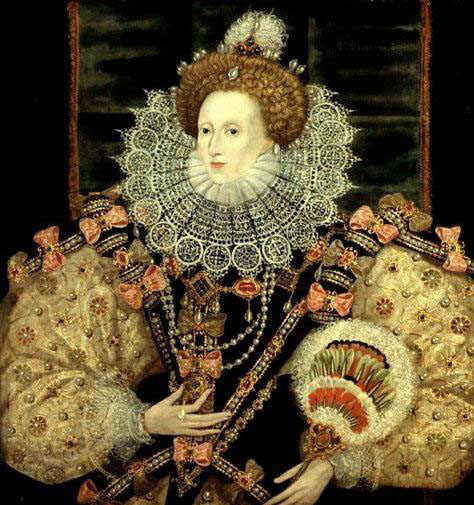
Elizabeth I by George Gower
Portraits of Queen Elizabeth I are the most complex and varied of all English royal portraiture, ranging from the earliest depiction of the submissive thirteen-year-old Princess to the most elaborate portraits of the commanding 'Virgin Queen'. Henry VIII, Elizabeth's father, had realized the political potential of the portrait, which he used to personify his divinely appointed power and emphasize the strength of the Tudor Dynasty. Elizabeth, however, was an unmarried female monarch in a patriarchal society and her determination not to marry caused unprecedented problems for portraitists. The idea of a single woman inheriting the throne and ruling the country was entirely alien. Rejecting the Renaissance advances in perspective and shading which had been introduced to England by Hans Holbein, Elizabeth cultivated a complex iconography, an uncompromising statement of her absolute imperial power, which changed the face of British painting until Van Dyck's arrival in 1620.
This regal portrait, attributed by Sir Roy Strong to the Queen's Sergeant-Painter George Gower, is a version of the famous 'Armada' portrait, the two most famous of which belong to the National Portrait Gallery, London and to Woburn Abbey. Gower's portrait, a celebration of victory against the Spanish, was a declaration of the strength of Elizabeth's rule. As Sir Roy Strong suggests, the painting can be read as a whole and in separate 'portions' at the same time. Elizabeth conveys simultaneously her authoritative body politic and her physical existence as a woman, carefully manipulating her sexuality to proclaim her power.
At Tilbury, when the Queen spoke to the English troops as the Spanish Armada approached, Elizabeth told her subjects that she was resolved in the midst and heat of the battle, to live or die amongst you all - to lay down for my God, and for my kingdoms, and for my people, my honor and my blood even in the dust. Here the Queen asserted her authority and her honor in a way usually reserved for men - that of fortitude in the face of battle. In the same manner, in the larger 'Armada' portraits, Elizabeth, whose heavily made-up face is endowed with political authority, asserts England's imperial power through her hand, which rests on a globe, in particular on the continent of North America. Above the globe rests the crown, a reminder of Elizabeth's constitutional power. In the background, the Spanish Armada approaches England in fair weather on Elizabeth's left, where evil traditionally sits, and meets its doom to the right.
In this version of Gower's masterpiece, Elizabeth's posture and the large sleeves of her dress dominate the pictorial space and echo the effect of Henry VIII's broad-shouldered stance in Holbein's late portraits. The bodice of her dress tapers into a stiff triangle, calling to mind an armored breastplate, whilst the patterns of pearls form a heraldic design. Costume carried an important political message in the Tudor court, indicating rank, as did coats of arms.
Elizabethan dress always is blindingly rich in lace work and jewelry. However, no costume should outshine the monarch's.
The eye is deliberately drawn to Elizabeth's face, the focal point on the canvas, other-worldly, its smooth pale skin translucent enough to show the underlying veins on her temple. The Queen, whose artistic mind worked entirely in symbolism, dismissed shadow as a counteraction to her image of purity and in later years she created a 'mask of youth' to sustain a public face of immortality, especially as she had not declared a successor. In the Rainbow Portrait, painted when she was aged sixty-three, she appears as a young maiden with loose hair, an uncovered chest and spring flowers, her hair spilling down like a bride's.
Elizabeth's femininity and proclaimed virginity is ever-present within her portraiture. In her delicate white hand she holds the familiar symbol of womanhood, a fan; her richly ornamented dress is decorated with large pink bows. Pearls were an overt reference to the Queen's virginity, while her favored colors, black and white, symbolized constancy and purity.
This portrait belonged to Charles I, an important connoisseur and voracious collector. He presented it to Judge Twysden, a staunch royalist throughout the political upheaval of the Civil War. At the Restoration, Judge Twysden was knighted and made a judge of the King's bench.
Quoted From: Portrait of Queen Elizabeth I by GEORGE GOWER - The Leicester Galleries
The combination of a life-sized portrait of the queen with a horizontal format is "quite unprecedented in her portraiture", although allegorical portraits in a horizontal format, such as Elizabeth I and the Three Goddesses and the Family of Henry VIII: An Allegory of the Tudor Succession pre-date the Armada Portrait.
The queen's hand rests on a globe below the crown of England, "her fingers covering the Americas, indicating England's dominion of the seas and plans for imperialist expansion in the New World". The Queen is flanked by two columns behind, probably a reference to the famous impresa of the Holy Roman Emperor, Charles V, Philip II of Spain's father, which represented the pillars of Hercules, gateway to the Atlantic Ocean and the New World.
In the background view on the left, English fire-ships threaten the Spanish fleet, and on the right the ships are driven onto a rocky coast amid stormy seas by the "Protestant Wind". On a secondary level, these images show Elizabeth turning her back on storm and darkness while sunlight shines where she gazes.
An engraving by Crispijn van de Passe (Crispin van de Passe), published in 1596 but showing costume of the 1580's, carries similar iconography. Elizabeth stands between two columns bearing her arms and the Tudor heraldic badge of a portcullis. The columns are surmounted by her emblems of a pelican in her piety and a phoenix, and ships fill the sea behind her.

Elizabeth I by Crispin van de Passe: 1596
The Cult of Elizabeth
The various threads of mythology and symbolism that created the iconography of Elizabeth I combined into a tapestry of immense complexity in the years following the defeat of the Spanish Armada. In poetry, portraiture and pageantry, the queen was celebrated as Astraea, the just virgin, and simultaneously as Venus, the goddess of love. Another exaltation of the queen's virgin purity identified her with the moon goddess who holds dominion over the waters. Sir Walter Raleigh had begun to use Diana and later Cynthia as aliases for the queen in his poetry around 1580, and images of Elizabeth with jewels in the shape of crescent moons or the huntress's arrows begin to appear in portraiture around 1586 and multiply through the remainder of the reign. Courtiers wore the image of the Queen to signify their devotion, and had their portraits painted wearing her colors of black and white.
The Ditchley Portrait seems to have always been at the Oxfordshire home of Elizabeth's retired Champion, Sir Henry Lee of Ditchley, and likely was painted for (or commemorates) her two-day visit to Ditchley in 1592. The painting is attributed to Marcus Gheerearts the Younger, and was almost certainly based on a sitting arranged by Lee, who was the painter's patron. In this image, the queen stands on a map of England, her feet on Oxfordshire. The painting has been trimmed and the background poorly repainted, so that the inscription and sonnet are incomplete. Storms rage behind her while the sun shines before her, and she wears a jewel in the form of a celestial or armillary sphere close to her left ear. Many versions of this painting were made, likely in Gheeraerts' workshop, with the allegorical items removed and Elizabeth's features "softened" from the stark realism of her face in the original. One of these was sent as a diplomatic gift to the Grand Duke of Tuscany and is now in the Palazzo Pitti.
_by_Marcus_Gheeraerts_the_Younger.jpg)
Queen Elizabeth I ('The Ditchley Portrait')
by Marcus Gheeraerts the Younger
The Last Sitting and the Mask of Youth
Around 1592, the queen also sat to Isaac Oliver, a pupil of Hilliard, who produced an unfinished portrait miniature used as a pattern for engravings of the queen. Only a single finished miniature from this pattern survives, with the queen's features softened, and Strong concludes that this realistic image from life of the aging Elizabeth was not deemed a success.
Prior to the 1590's, woodcuts and engravings of the queen were created as book illustrations, but in this decade individual prints of the queen first appear, based on the Oliver face pattern. In 1596, the Privy Council ordered that unseemly portraits of the queen which had caused her "great offence" should be sought out and burnt, and Strong suggest that these prints, of which comparatively few survive, may be the offending images. Strong writes "It must have been exposure to the searching realism of both Gheeraerts and Oliver that provoked the decision to suppress all likenesses of the queen that depicted her as being in any way old and hence subject to mortality."
In any event, no surviving portraits dated between 1596 and Elizabeth's death in 1603 show the aging queen as she truly was. All subsequent images rely on a face pattern devised by Nicholas Hilliard sometime in the 1590's called by art historians the "Mask of Youth", portraying Elizabeth as ever-young. Some 16 miniatures by Hilliard and his studio are known based on this face pattern, with different combinations of costume and jewels likely painted from life, and it was also adopted by (or enforced on) other artists associated with the Court.
The Coronation Portraits
Two portraits of Elizabeth in her coronation robes survive, both dated to 1600 or shortly thereafter. One is a panel portrait in oils and the other is a miniature by Nicholas Hilliard. The warrant to the queen's tailor for remodeling Mary I's cloth of gold coronation robes for Elizabeth survives, and costume historian Janet Arnold's study points out that the paintings accurately reflect the written records, although the jewels differ in the two paintings, suggesting two different sources, one possibly a miniature by Levina Teerlinc. It is not known why, and for whom, these portraits were created; at or just after the end of the reign.

Elizabeth I, Coronation Miniature: ca 1600
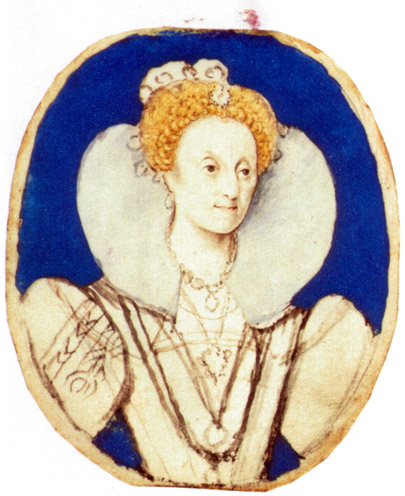
Elizabeth I of England Unfinished
by Isaac Oliver
The Rainbow Portrait
Attributed to Isaac Oliver, perhaps the most heavily symbolic portrait of the queen is the Rainbow Portrait. It was painted around 1600-1602, when the queen was in her sixties. In this painting an ageless Elizabeth appears dressed as if for a masque, in a linen bodice embroidered with spring flowers and a mantle draped over one shoulder, her hair loose beneath a fantastical headdress. She wears symbols out of the popular emblem books: the cloak with eyes and ears, the serpent of wisdom, the celestial armillary sphere, and carries a rainbow with the motto non sine sol iris ("no rainbow without the sun"). Strong suggests that the complex "programme" for this image may be the work of the poet John Davies, whose Hymns to Astraea honoring the queen use much of the same imagery, and suggests it was commissioned by Robert Cecil as part of the decor for Elizabeth's visit in 1602, when a "shrine to Astraea" featured in the entertainments of what would prove to be the "last great festival of the reign".
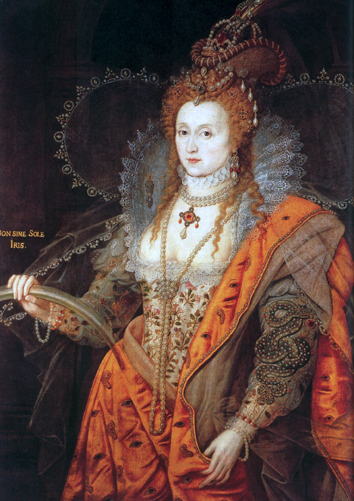
Elizabeth I, Rainbow Portrait: ca 1600-01
Books and Coins
Prior to the wide dissemination of prints of the queen in the 1590's, the common people of Elizabeth's England would be most familiar with her image on the coinage. In December 1560, a systematic re-coinage of the debased money then in circulation was begun. The main early effort was the issuance of sterling silver shillings and groats, but new coins were issued in both silver and gold. This restoration of the currency was one of the three principal achievements noted on Elizabeth's tomb, illustrating the value of stable currency to her contemporaries. Later coinage represented the queen in iconic fashion, with the traditional accompaniments of Tudor heraldic badges including the Tudor rose and portcullis.
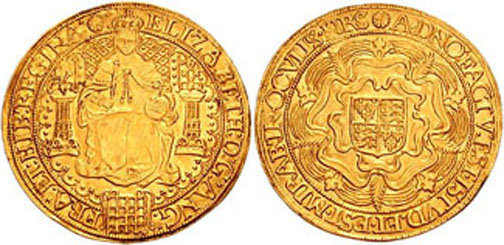
Sovereign Elizabeth: 1585
Books provided another widely-available source of images of Elizabeth. Her portrait appeared on the title page of the Bishops' Bible, the standard Bible of the Church of England, issued in 1568 and revised in 1572. In various editions, Elizabeth is depicted with her orb and scepter accompanied by female personifications.
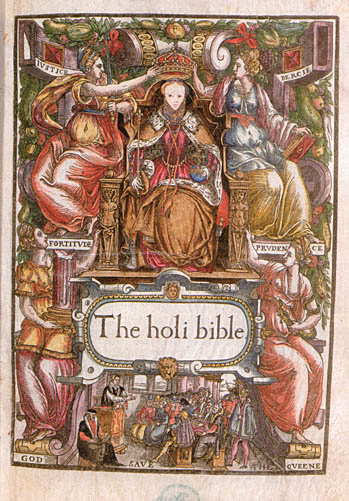
Bishops' Bible -Elizabeth I: 1569
Reading the Portraits
It may be impossible for modern viewers to see the hundreds of images of Elizabeth as her subjects, courtiers, and rivals saw them. The portraits are steeped in classical mythology and the Renaissance understanding of English history and destiny, filtered by allusions to Petrarch's sonnets and, late in the reign, to Edmund Spenser's Faerie Queene. Dame Frances Yates points out that the most complexly symbolic portraits may all commemorate specific events or have been designed as part of elaborate themed entertainments. The most familiar images of Elizabeth-the Armada, Ditchley, and Rainbow Portraits-are all associated with unique events in this way. To the extent that the contexts of other portraits have been lost to scholars, so too the keys to understanding these remarkable images as the Elizabethans understood them may be lost in time. Even those portraits that are not overtly allegorical may be full of meaning to a discerning eye. Elizabethan courtiers familiar with the language of flowers and the Italian emblem books could have read stories in the blooms the queen carried, the embroidery on her clothes, and the design of her jewels.
According to Roy Strong:
Fear of the wrong use and perception of the visual image dominates the Elizabethan Age. The Old Pre-Reformation idea of images, religious ones, was that they partook of the essence of what they depicted. Any advance in technique which could reinforce that experience was embraced. That was now reversed, indeed it may account for the Elizabethans failing to take cognizance of the optical advances which created the art of the Italian Renaissance ... They certainly knew about these things but, and this is central to the understanding of the Elizabethans, chose not to employ them. Instead the visual arts retreated in favor of presenting a series of signs or symbols through which the viewer was meant to pass to an understanding of the idea behind the work. In this manner the visual arts were verbalized, turned into a form of book, a 'text' which called for reading by the onlooker. There are no better examples of this than the quite extraordinary portraits of the queen herself, which increasingly, as the reign progressed, took on the form of collections of abstract pattern and symbols disposed in an naturalistic manner for the viewer to unravel, and by doing so enter into an inner vision of the idea of monarchy."
From: Portraiture of Elizabeth I of England - WikipediaVarious Paintings of the Elizabethan Era
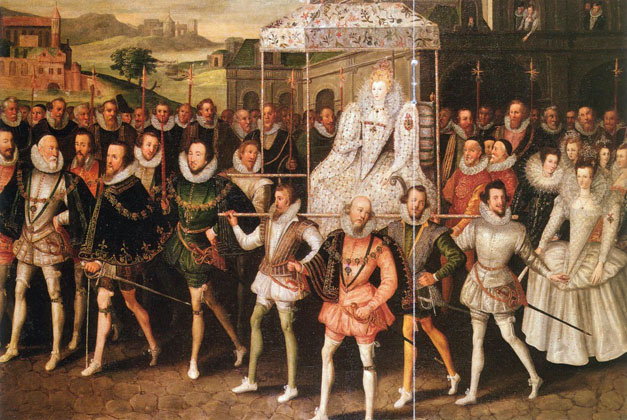
Elizabeth I, Procession Portrait: ca 1600

Elizabeth I: 1560-65
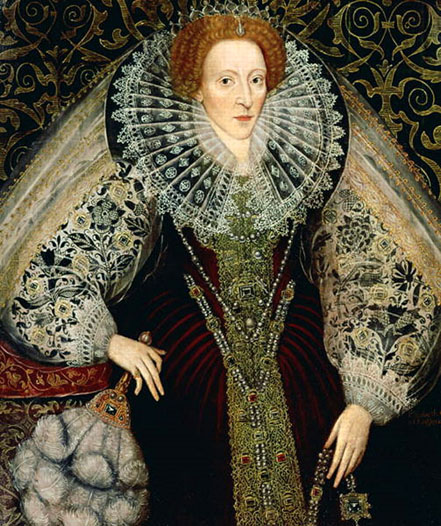
Elizabeth I attributed to Lohn Bettes: ca 1585-90

Elizabeth I: ca 1559
(Unknown Artist)
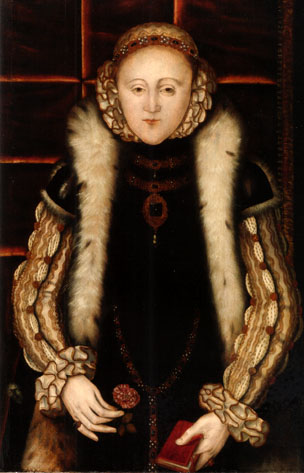
Elizabeth I - English School: ca 1560
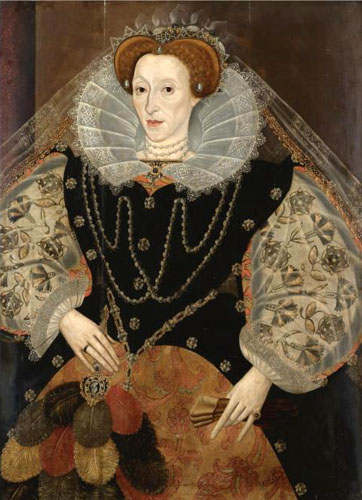
Elizabeth I - English School ca: 1595

Elizabeth I in Parliament Robes
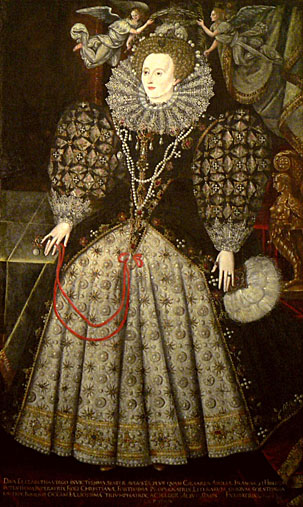
Elizabeth I, Jesus College
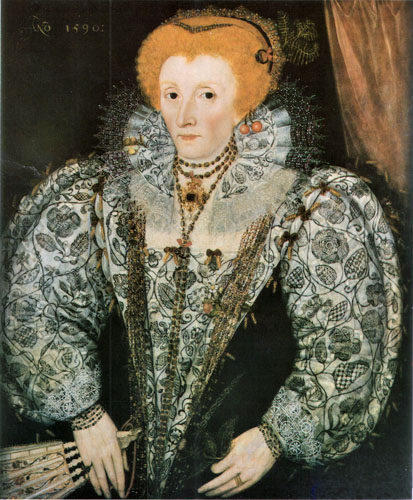
Elizabeth I, Jesus College Oxford: 1590
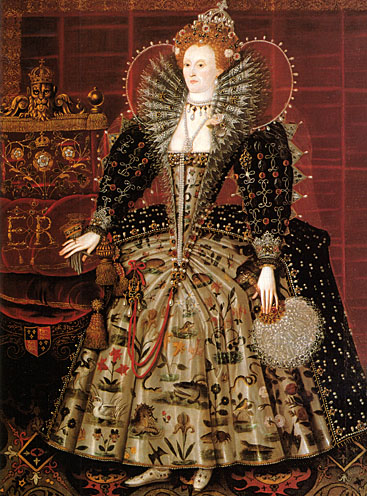
Elizabeth I of England Hardwick: 1592

Elizabeth I of England
by Marcus Gheeraerts the Elder

Elizabeth I - Palazzo Pitti Florence
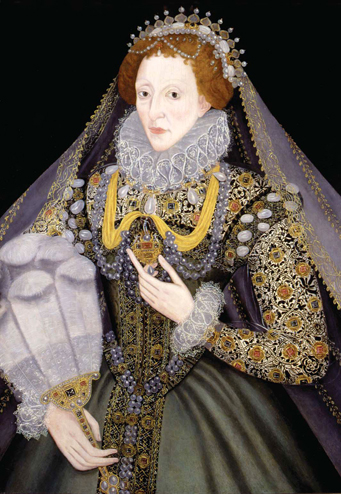
Elizabeth I by Unknown Artist: 1570's
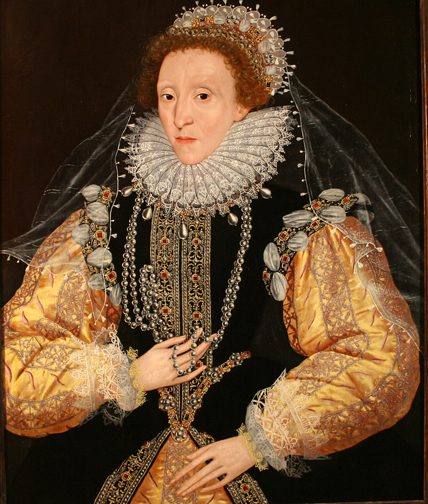
Elizabeth I Drewe Portrait by George Gower
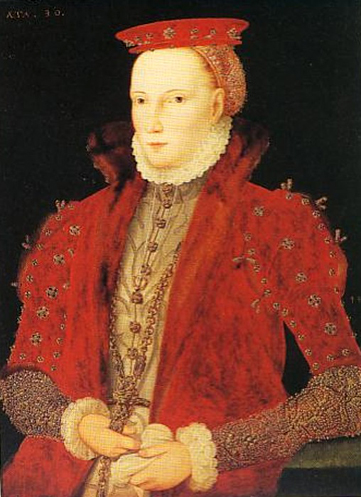
Gripsholm Elizabeth

The Schloss Ambras Portrait,
Unknown Artist: 1575–80
Tudor Geneology
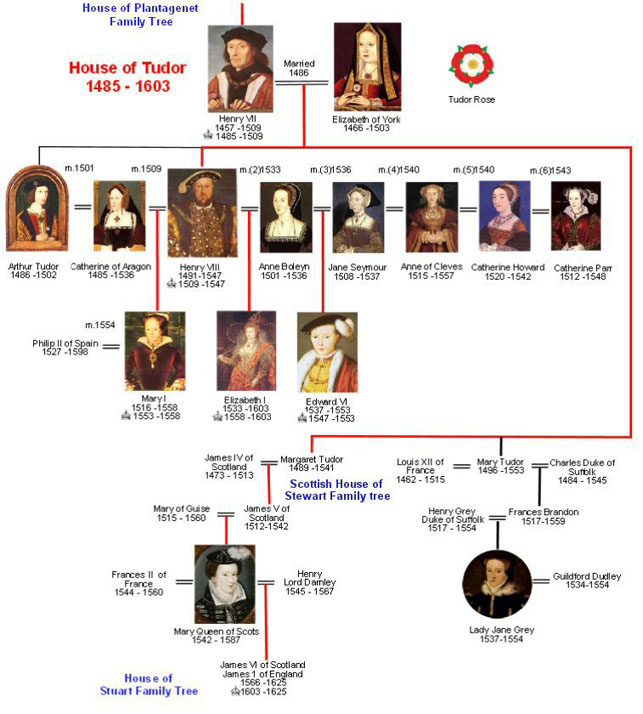
Return to Pagina Artis
Return to Bruce and Bobbie's Main Page.